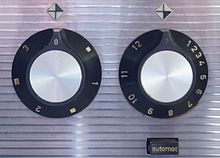Seven-stroke circuit
The combination of a cooking zone ( hotplate ) and the associated switch in an electric stove is called seven- step switching . The switch has seven positions with which the user can choose between six different power levels when operating the cooking zone ; the off position is added as the seventh position. The switch positions are labeled with 1 to 6 or ½ to 3 , depending on the model . In addition to the switch position, the absolute power depends on the design-related nominal power of the cooking zone, which is usually selected depending on its diameter . In addition, there are also different versions with the same diameter, whereby the thicker hotplate is sometimes called a quick or flash hotplate and is marked with a red dot.
The heating element of a corresponding seven-stroke cooking zone is divided into three partial heating elements of different power by two taps. Therefore, such a hotplate or the heating element has four connections. Depending on the position, the associated switch switches the partial heating elements together in different combinations and connects them to the power supply . In the smallest position all partial heating elements are connected in series , while in the maximum position they are all connected in parallel . For details see web link.
A comparable circuit is the four-cycle circuit, with two partial heating elements being able to choose from three power levels (in addition to off ). The four-stroke circuit can only be found in older models.
An alternative option for power control is the energy regulator , which regularly switches the cooking zone on and off (similar to a vibration package control ) and thus controls the power through pulse width modulation . There are also thermostat- controlled hotplates (automatic hotplates) that have a sensor that is pressed against the bottom of the pot . In both cases, the associated control button offers a stepless setting option.
Web links
source
- Jump up ↑ Josef Scholz: 4-stroke and 7-stroke ground circuits. October 14, 2013, accessed November 9, 2016 .
